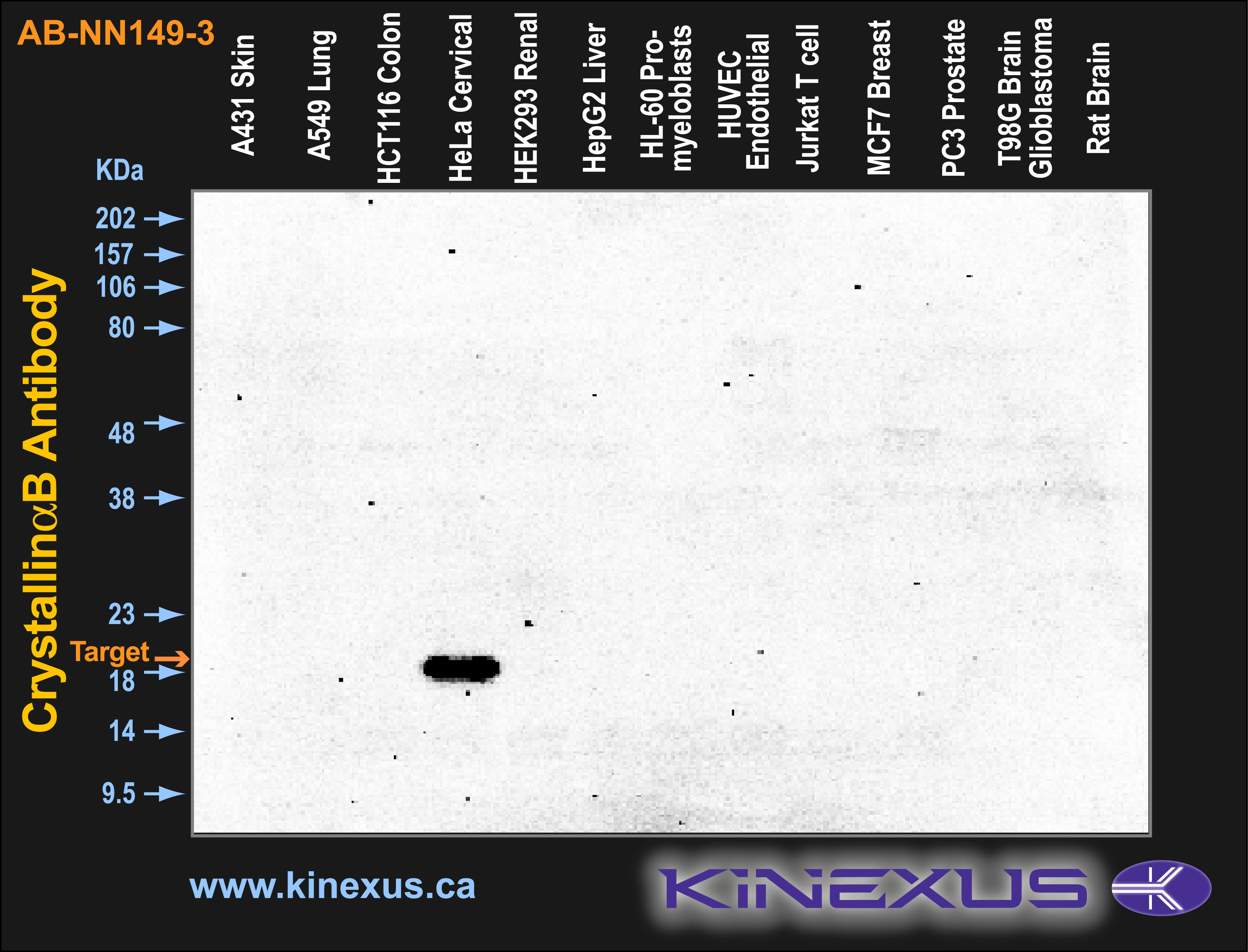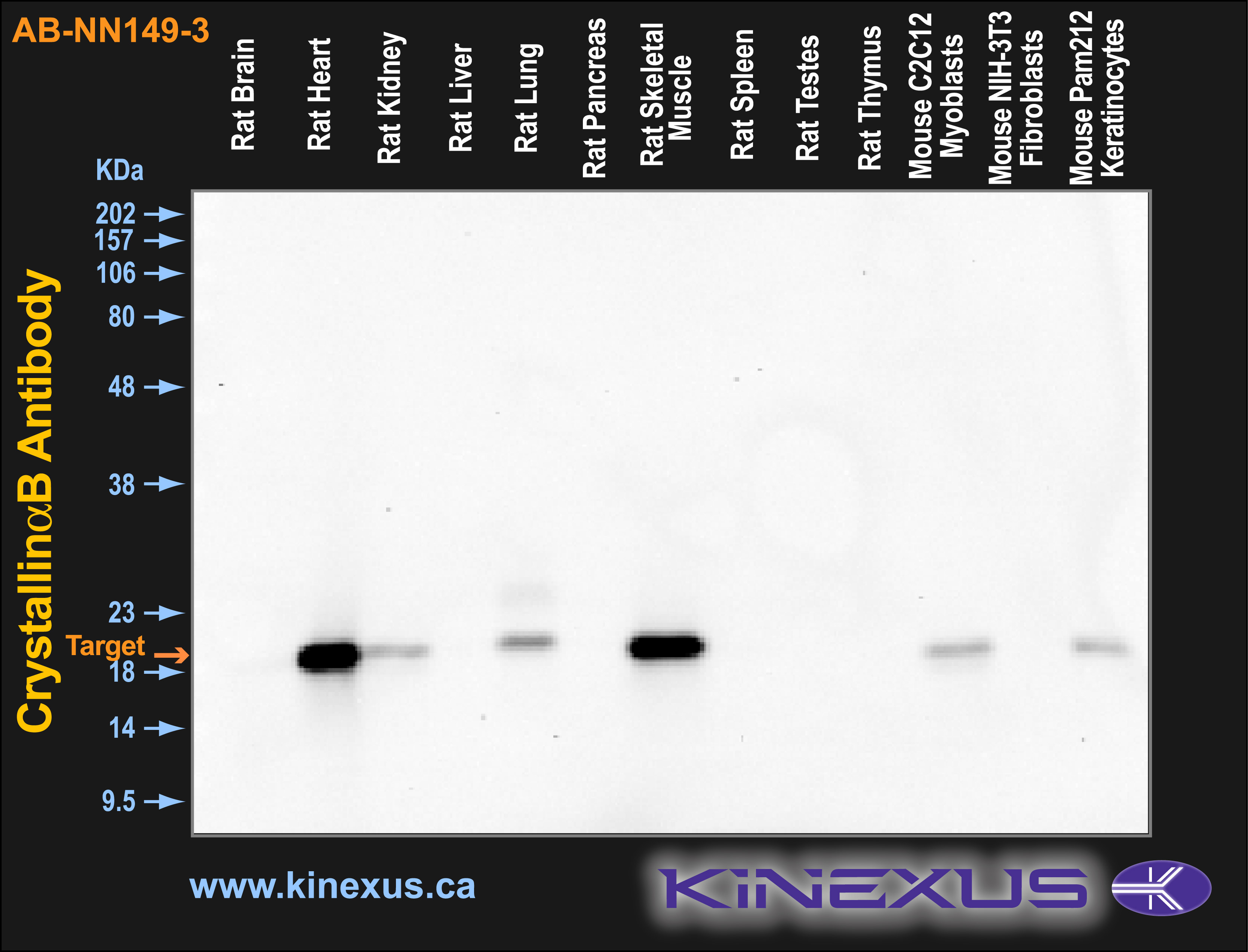Product Name: Alpha B Crystallin
Product Number: AB-NN149-3
| Size: | 50 µg | Price: | 89.00 | |
| $US |
Target Full Name: Alpha-crystallin B chain
Target Alias: AACRYA; Alpha crystallin B chain; CRYA2; CRYAB; CTPP2; HSPB5; NY REN 27 antigen
Product Type Specific: Heat shock/stress protein pan-specific antibody
Antibody Code: NN149-3
Antibody Target Type: Pan-specific
Protein UniProt: P02511
Protein SigNET: P02511
Antibody Type: Monoclonal
Antibody Host Species: Mouse
Antibody Ig Isotype Clone: IgG1
Antibody Immunogen Source: Native Alpha B Crystallin
Target Alias: AACRYA; Alpha crystallin B chain; CRYA2; CRYAB; CTPP2; HSPB5; NY REN 27 antigen
Product Type Specific: Heat shock/stress protein pan-specific antibody
Antibody Code: NN149-3
Antibody Target Type: Pan-specific
Protein UniProt: P02511
Protein SigNET: P02511
Antibody Type: Monoclonal
Antibody Host Species: Mouse
Antibody Ig Isotype Clone: IgG1
Antibody Immunogen Source: Native Alpha B Crystallin
Production Method: Protein G purified
Antibody Modification: Unconjugated. Contact KInexus if you are interest in having the antibody biotinylated or coupled with fluorescent dyes.
Antibody Concentration: 1 mg/ml
Storage Buffer: Phosphate buffered saline pH7.2, 50% glycerol, 0.09% sodium azide
Storage Conditions: For long term storage, keep frozen at -40°C or lower. Stock solution can be kept at +4°C for more than 3 months. Avoid repeated freeze-thaw cycles.
Product Use: Western blotting | ELISA
Antibody Dilution Recommended: WB (1:2000); optimal dilutions for assays should be determined by the user.
Antibody Modification: Unconjugated. Contact KInexus if you are interest in having the antibody biotinylated or coupled with fluorescent dyes.
Antibody Concentration: 1 mg/ml
Storage Buffer: Phosphate buffered saline pH7.2, 50% glycerol, 0.09% sodium azide
Storage Conditions: For long term storage, keep frozen at -40°C or lower. Stock solution can be kept at +4°C for more than 3 months. Avoid repeated freeze-thaw cycles.
Product Use: Western blotting | ELISA
Antibody Dilution Recommended: WB (1:2000); optimal dilutions for assays should be determined by the user.
Antibody Potency: High potency. Detects a ~20 kDa protein in cell and tissue lysates by Western blotting.
Antibody Species Reactivity: Human | Rat | Bovine
Antibody Positive Control: 0.5 µg/ml of SMC-165 was sufficient for detection of 50ng purified alpha B crystalline by colorimetric immunoblot analysis using Goat anti-mouse IgG:HRP as the secondary antibody.
Antibody Specificity: Very high
Antibody Cross Reactivity: Does not cross-react with αA-crystallin, βL-crystallin, ΒH-crystallin, γ-crystallin, HSP25, HSP27 or HSP47 proteins.
Related Product 1: Alpha B Crystallin pan-specific antibody (Cat. No.: AB-NN149-1)
Antibody Species Reactivity: Human | Rat | Bovine
Antibody Positive Control: 0.5 µg/ml of SMC-165 was sufficient for detection of 50ng purified alpha B crystalline by colorimetric immunoblot analysis using Goat anti-mouse IgG:HRP as the secondary antibody.
Antibody Specificity: Very high
Antibody Cross Reactivity: Does not cross-react with αA-crystallin, βL-crystallin, ΒH-crystallin, γ-crystallin, HSP25, HSP27 or HSP47 proteins.
Related Product 1: Alpha B Crystallin pan-specific antibody (Cat. No.: AB-NN149-1)
Related Product 2: Alpha B Crystallin pan-specific antibody (Cat. No.: AB-NN149-2)
Related Product 3: Alpha A Crystallin pan-specific antibody (Cat. No.: AB-NN149-5)
Related Product 3: Alpha A Crystallin pan-specific antibody (Cat. No.: AB-NN149-5)
Scientific Background: The alpha-crystallins are major water-soluble lens structural proteins of the vertebrate eye that are related to the small heat shock protein family. The alpha-crystallins possess structural and functional similarities with HSP25 and HSP27 (1). Mammalian lens cystallins are divided into alpha, beta and gamma families. Alpha and beta families are further divided into acidic and basic groups (Alpha-A and Alpha-B respectively). In the lens, alpha-crystallin primarily functions to maintain proper refractive index, however it can also function as a molecular chaperone that binds to the denatured proteins, keeping them in solution and thereby maintaining the translucency of the lens. When cellular stress occurs, alpha-crystallin enters its’ phosphorylated state and may serve a structural control function and play a role in protein maintenance (2). In addition to their interaction with proteins, alpha-crystallins also interact with native molecules such as membrane proteins, Golgi matrix protein, structural proteins, nuclear proteins and DNA (3, 4, 5, 6, and 7). Two other functions are an autokinase activity and participation in the intracellular architecture, and it has also been proven that both alpha-A and B prevent apoptosis by inhibiting caspases (8). Specifically, alpha-B cystallin is found in many cells and organs outside the lens, and alpha B is overexpressed in several neurological disorders and in cell lines under stress conditions (9).
Figure 1. Immunoblotting of various cell lines with AB-NN149-2 antibody at a 50 X dilution. The target protein Crystallin aB is indicated. Each lane was loaded with 15 µg of cell lysate protein. The max signal count was 3085.
Figure 2. Immunoblotting of various tissue lines with AB-NN149-2 antibody at a 50 X dilution. The target protein Crystallin aB is indicated. Each lane was loaded with 15 µg of tissue lysate protein. The max signal count was 29796.
References
[1] Merck K.B. et al. (1993) J Biol Chem. 268: 1046-1052.
[2] Horwitz J. (1992) Proc Natl Acad Sci USA. 89(21): 10449-10453.
[3] Cobb B.A. and Petrash J.M. (2002) Biochemistry. 41: 483-490.
[4] Bullard B. et al. (2004) J Biol Chem. 279: 7917-7924.
[5] Gangalum R.K., Schibler M.J. and Bhat S.P. (2004) J Biol Chem. 279: 43374.43377.
[6] Maddala R. and Rao V.P. (2005) Exp Cell Res. 306: 203-215.
[7] Yaung J. et al. (2007) Molecular Vision 13: 566-577.
[8] Head M.W. et al. (2000) Neuropathol Appl Neurobiol. 26: 304-312.
[1] Merck K.B. et al. (1993) J Biol Chem. 268: 1046-1052.
[2] Horwitz J. (1992) Proc Natl Acad Sci USA. 89(21): 10449-10453.
[3] Cobb B.A. and Petrash J.M. (2002) Biochemistry. 41: 483-490.
[4] Bullard B. et al. (2004) J Biol Chem. 279: 7917-7924.
[5] Gangalum R.K., Schibler M.J. and Bhat S.P. (2004) J Biol Chem. 279: 43374.43377.
[6] Maddala R. and Rao V.P. (2005) Exp Cell Res. 306: 203-215.
[7] Yaung J. et al. (2007) Molecular Vision 13: 566-577.
[8] Head M.W. et al. (2000) Neuropathol Appl Neurobiol. 26: 304-312.
© Kinexus Bioinformatics Corporation 2017



